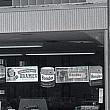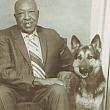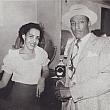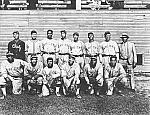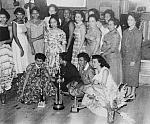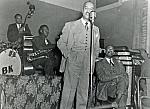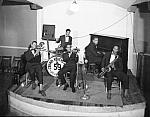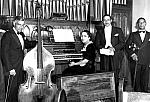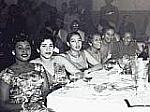
Genoa Cafe and Roma Hall
by Kim Rush, John Russo, and Martin Starr
Russo’s Grand Rapids Press announcement also boasted “floor show” type entertainment featuring a torch singer, a tap dancer, as well as the Royal Victorian Orchestra. Italian food and beer were offered. Instead of renting Roma Hall to clients, Russo had created his own nightclub or beer “garden,” modeling his business after a number of similar current nightspots in the Grand Rapids area. There were at least three other nightspots on the same street as his place, namely The Chicken Coop at 4138 South Division, the Brown Derby, located south of 4000 South Division and The Southern Barbeque at 4157 Division. Most “cafes” served food as well as alcoholic beverages, after the end of prohibition. These venues also featured “floor” shows and provided dance orchestras.
Russo used the name “Genoa Café” for a little over a year, with advertisements appearing in the Grand Rapids Press from 12.2.33 until 2.10.34. During the summer of 1934, Russo adopted a new name for his venue, the “Russo Café.” At this point, his dance hall was still located alongside the amalgam of family apartments. Based on the ads for “Russo Café,” there appears to have been little change in his business format other than the name change. G.B. was still running his own nightclub, selling his family’s Italian culinary creations, as well as beer and wine to his customers. Russo Café ads ranged from July of 1934 until July of 1935. The presentations sometimes varied, however. For example, the advertisement for 7.19.34 offered a combination of a boxing match and a floor show, also claiming that he had hired the best band in town, in addition to selling chicken dinners. On the nights that the café was closed he’d rent the hall for various events such as private parties for the Italian and Syrian community, advertised weekend public dances, jam sessions, weddings, black cotillion debutante balls, political rallies, dinners, meetings, conventions, parties, and concerts.
Layout of Roma Hall
John Russo provided the following description for the layout of Roma Hall: “There was a restroom located behind the old gazebo stage. I recall an old clock that was hung near this stage area. There was also a large kitchen and bar located to the right of the old stage area, which was near the back alley stairway entrance that was accessed from Franklin Street. Bands used this stairway to transport their equipment up to the hall. We also had a large beer cooler that was still working when the building was demolished in 1991. There were skylights in the ceiling of the hall and the nearby apartment, too. There was a designated Roma Hall customer entrance on Division which provided a stairway to climb from the sidewalk up to the hall. In 1949, G.B. and my father Frank had an addition built, which was attached to the rear portion of the existing building. This expanded Roma Hall from 3652 to 5762 square feet. [1] At the time that the addition was built, they also installed two regular size doors to allow passage between both halves of the hall.”
“But this area near the old stage eventually became too congested during larger events. So in 1957 my dad decided to demolish the old gazebo stage, the restroom, and all the other clutter, located at the center of the hall. The two sides of the hall were then divided by two large garage (overhead) doors that could be either opened or closed, depending on the size of event. If two events were taking place simultaneously, then both doors were kept closed. If there was a second event being held in the east end of the hall, people could use the back stairway to enter or leave.”
[1] City assessor files for 746-750 South Division S. E., Grand Rapids MI, housed at Grand Rapids City Archives.

 facebook
facebook